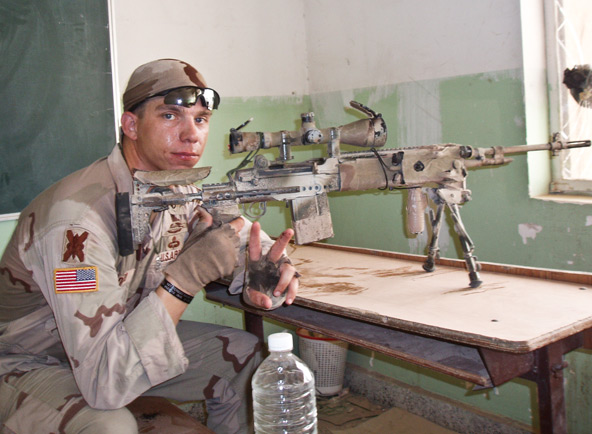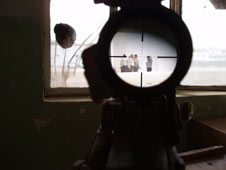
Iraq, 2005. Joe Romero in a hide.
Photo: Unknown
Salihee was driving west. It was midday and most of the soldiers in the patrol had just entered a four-story building on the south side of the street to search for suspected insurgents on the roof. A few stayed down on the street to provide security. On the north side of the street stood two U.S. snipers; across the street an American from the same unit and at least one Iraqi soldier were posted. The street was left open to traffic: The patrol had not blocked off the street with cones and concertina wire, as they normally would for a cordon and search operation. The soldiers decided to stop cars by standing in the street and aiming their rifles at the drivers.
As Salihee approached the patrol from the east, another car was turning around in front of him. He began to drive around it to the right. Exactly what happened next is in dispute. What is certain is that as Salihee went around the car, the two U.S. snipers, thinking he was a suicide bomber, opened fire. At least four rounds were fired. One blew out the car's right front tire; another ricocheted off the ground and pierced the gas tank. The final 7.62 millimeter round pierced the driver's side of the windshield, entering Salihee's right eye and shattering his skull. Salihee died instantly.
The American troops left the car in the street and moved to a different position. An hour after the shooting, an Iraqi policeman found Salihee's phone and called his wife, Raghad. Raghad arrived at the scene and found her husband's body still slumped in the car, and she called an ambulance. Then she sat down on the curb and wept.
Salihee was not a suicide bomber. He was a physician and journalist who was going to his house on his day off to pick up his 2-year-old daughter, Dania, and take her swimming. Barely able to make ends meet on the meager salary paid doctors by the Iraqi Health Ministry, Salihee had talked his way into a reporting job at Knight-Ridder in early 2004. He earned bylines in the San Jose Mercury News and other major U.S. papers by writing about detainees who had been tortured by Iraqi police and the dangers faced by men driving alone in the city. After his death, anguished tributes from colleagues and friends flooded the Internet and the papers, even NPR.
I first met Yasser Salihee in May, through his younger brother, Ayman, who works as my interpreter. Whenever Ayman needed a contact or a piece of advice, he called his older brother for the answer, which meant they were on the phone all the time. They were very close, and it wasn't long before I met Yasser, who wanted to help on an investigative story. Over the course of a few weeks, we grew to be friends as we worked to find leads and uncover the past of the main subject, a member of the Iraqi National Assembly. Yasser worked in his off-hours to find leads and would show up at the hotel with his latest haul of phone numbers and ideas. In his rimless glasses and perfectly pressed shirt, Yasser came across more as a scientist than a reporter. He was a man with a great deal of curiosity and respect for facts. He also had no problem telling me what to do. Once, when he thought I needed a haircut, he sent the barber to my hotel room so there would be no escape.
In early June, Yasser stopped by and we talked about what he was going to do after his stint as a journalist. I said he shouldn't give up on it, that Iraq needed reporters. "Yeah, but this isn't going to last forever," Yasser said.
Three weeks after that conversation, just after I returned from a trip to Fallujah, Ayman called and said that his brother had been shot and killed by U.S. soldiers. Ayman was in shock. I felt revulsion toward the soldiers, a sense of betrayal. At the end of the conversation he told me, "Don't worry, you are still my brother. Don't worry." He wanted me to know we were still friends despite his shattered trust in the U.S. Later on he would say, "You don't know what I'm feeling," and it was true. There weren't words for it.
A few days after Ayman told me about Yasser's death, I decided to search for the soldier who pulled the trigger and look for answers about the shooting. I wanted to hear what happened in the soldier's own words. The story presented a serious difficulty: I could not tell the U.S. military that I was working on Salihee's killing: Third Infantry Division Public Affairs officers will not help a reporter who is working on a "negative" report about civilian casualties, and one such officer told me as much. To date, the U.S. military has refused to release any figures about the civilians it has killed, although it keeps very detailed records of every incident.
So I requested an embed slot in western Baghdad without mentioning the killing and hoped to find the soldiers involved by tracking down which unit was at the intersection of Amel Al Shabi and Rafaee streets. Two weeks later, after a lucky break, I was able to find the unit and the man who fired the fatal shot. To increase the chances of finding the soldier, I asked to embed with the company that patrolled the area, part of the 256th Brigade Combat Team. It was a matter of knowing which unit identifying numbers were on the vehicles in the neighborhood and making a rough guess whom to embed with. Ayman and I visited the intersection where the shooting occurred so I could see it and talk to eyewitnesses. The street is full of people, mostly men selling bread or hardware. It's a busy commercial district that borders a major artery in the western sector of the city, and an easy place to recognize.
The Editor and Publisher called the Victim and the Killer one of the most remarkable stories to come out of Iraq.
 LEAD IMAGE: Iraq, 2005. Joe Romero looks through the sight of his sniper rifle at a group of men.
LEAD IMAGE: Iraq, 2005. Joe Romero looks through the sight of his sniper rifle at a group of men.Photo: Sergeant Joe Romero
© Phillip Robertson, 2009-2014.
